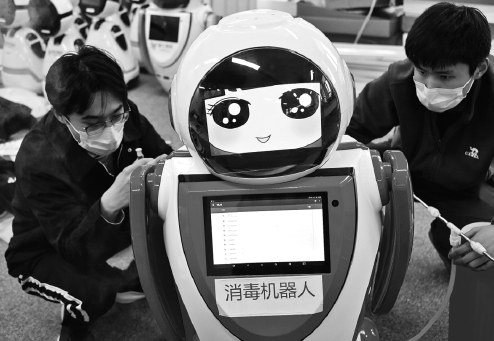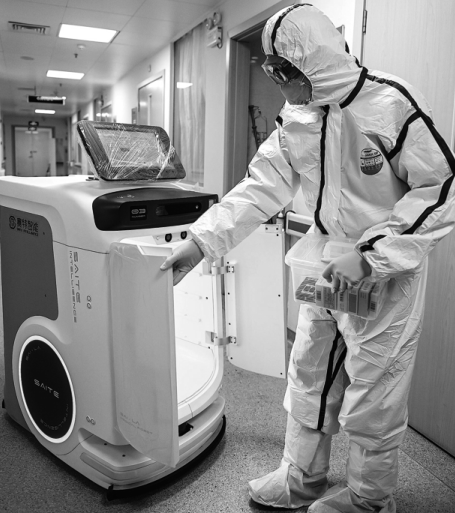Magnificent robots make medical magic
Custom automation promises to evolve into trillion-yuan industry as demand surges amid novel coronavirus spread

Pan Jing, founder of Shanghai TMiRob Technology, is a little bit overwhelmed by the unprecedentedly huge demand for the firm's disinfection robots after the novel coronavirus epidemic hit China hard.
"We have come across great challenges in our supply chain over the past week. All our inventory has been exhausted. Even the robot model demonstrated in the exhibition hall of our company has been purchased and delivered," he said on Feb 6.
The company wasted no time. Staff at TMiRob have been working overtime during the Chinese Lunar New Year holiday. To help combat the virus, TMiRob has so far delivered 42 disinfection robots to Hubei province, where the most infections have been reported. That number of delivered machines is equal to one-sixth of the company's monthly output, said Pan.
By combining chloric acid and plasma, the company's robot can disinfect the environment where both human beings and machines are present. The robot can move around on its own and deliver intensive disinfection services in areas frequented by patients and medical workers alike. The robot can operate automatically so it can minimize people's extra exposure to the hospital environment, said Pan.
At present, TMiRob's disinfection robot has been used in 60 hospitals in China, among which 14 are based in Shanghai, said Pan. Another 70 Chinese hospitals are using other robot models produced by the company. With more staff returning to their positions after the holiday, the company is expected to produce 300 robots every month, he said.
Founded in January 2015, TMi-Rob has mainly targeted the high-end medical service robots. One year later, the company obtained the first patent for invention. Two of its robot models entered on-site trials at a hospital in Wuhan, capital of Hubei province that has become somewhat infamous as the epidemic's epicenter.
TMiRob has completed four rounds of financing, with the disclosed amount reaching over 250 million yuan ($35.6 million). The company's major investors include ZJ Venture, the investment arm of Shanghai's Zhangjiang High-Tech Park, prominent venture capital firms CDH Investments and IDG, and Ecovacs, China's largest in-home robotic products manufacturer.
Similarly, the automatic mobile disinfection robot made by Shanghai Lingzhi Technology Co Ltd has started its on-site application in hospitals in Wuhan and Shanghai during the ongoing fight against the novel coronavirus.
Zhang Kejun, the company's general manager, said the robot is installed with an internal disinfection system that can release disinfection gas. The machine is capable of autonomous navigation and replace human beings in the performance of tasks like complete disinfection in epidemic areas. A robot can carry a maximum 1,500 milliliters of disinfectant, providing three hours of nonstop work each time.
Two robots that can transport medical and daily goods have been used at Guangdong Provincial People's Hospital. They are believed to be the first of their kind to be deployed in quarantined wards.
Robot Pingping is responsible for moving medicines and food. Robot An'an handles medical waste and contaminated goods. A robot can work six to eight hours on a single charge over 20 minutes, and can go to the charging point by itself when power is low. It is also easy to sterilize the machines after work.
Luo Xiaodan, deputy director of the infectious disease department of the hospital, said that the robots, donated by a technology company, were handed over to the hospital on Jan 28 and pressed into service after two days of test runs.
Luo's department is engaged in screening suspected cases, and is also responsible for collecting highly detailed information on patients' latest movements and behavior, besides providing medical treatment, if necessary. The department's doctors and nurses have shouldered heavy workload since the coronavirus outbreak, said Luo.
The newly introduced robots can save the medical workers the frequent need to put on and take off heavy protective outfits, including clothing, masks, goggles and boots, and help reduce the risk of infection. It takes an hour to put on and take off the whole set, said Luo.
Besides, the robots help save the outfit supply, which is rather stretched nationwide in the overwhelming work of treating the patients and screening suspected cases.
According to global market research firm Boston Consulting Group, the market value of the world's medical robot industry will reach $11.4 billion by the end of this year, making it the second-largest segment of the entire robotics industry.
According to Askci Consulting Co Ltd's estimates, the market value of China's medical robots reached $600 million in 2019 and the number will likely top $1 billion by 2021.
While robots have strengthened healthcare services during the contagion, virtual clinics and online medical services proved to be of great help as well.
Starting from Jan 29, a team of 10 leading experts from Guangdong province, led by Zhong Nanshan, a prominent Chinese expert in respiratory diseases, has been providing online consultations to remote cases, especially those in critical conditions. They read CT scan reports, discuss prescriptions and explain the use of medical devices.
Duan Yufei, director of the Health Commission of Guangdong Province, said such remote consultations led by Zhong are held at least once a day and have been normalized to help as many patients as possible. Meanwhile, about 60 hospitals in Guangdong alone have now launched remote consultations.
Similarly, the virtual assistant developed by Shanghai Udesk Co Ltd has been used in Putuo district of northwestern Shanghai to provide epidemic screening services. The virtual assistant can answer 200 phone calls in five minutes and provide results simultaneously.
It can gather target people's identification information, recent contacts and symptoms. With the information confirmed, the virtual assistant will classify the data and come up with statistical results instantly. Such job will usually take four hours for people to finish.
Xiao Hongliang, senior research manager of global research firm IDC in China, said that robots embedded with artificial intelligence as well as virtual doctors have been widely adopted in Chinese hospitals. Medical robots are sure to be better integrated into medical equipment to further improve medical standards, he said.
Although overwhelmed by instant fame, Pan of TMiRob tries to remain cool-headed, saying that medical robots are at the very early stage in China.
Medical robot providers should now focus on how to discover the true market demand and the various scenarios in hospitals. It will take about 10 years for the medical robot industry to reach a true inflection point, growing into an industry valued over 1 trillion yuan, he said.
"There are still many uncertainties, going forward. There will be numerous challenges for each company," said Pan.
Zheng Caixiong contributed to the story.


Today's Top News
- Xi urges all-out rescue efforts after floods hit Gansu
- Xi says China will continue to promote peace talks in Ukraine crisis
- Leaders of over 20 countries to attend SCO Tianjin Summit
- Xi urges all-out rescue efforts following mountain torrents in Gansu
- A Quixotic quest to reindustrialize US
- Grassroots sports events promoting nation's fitness goals






























